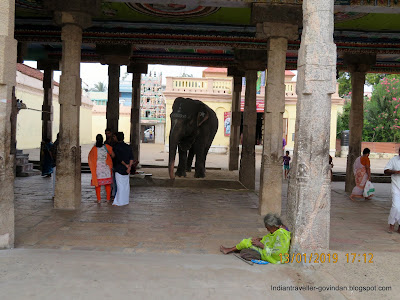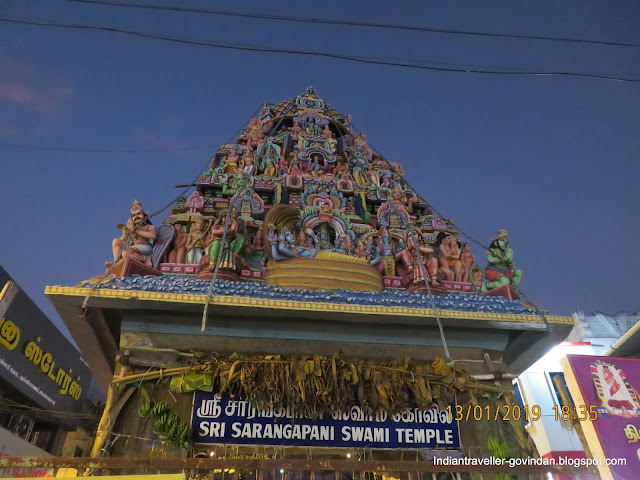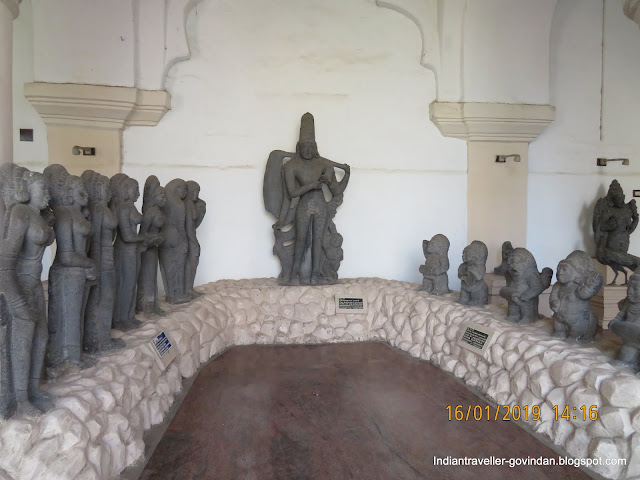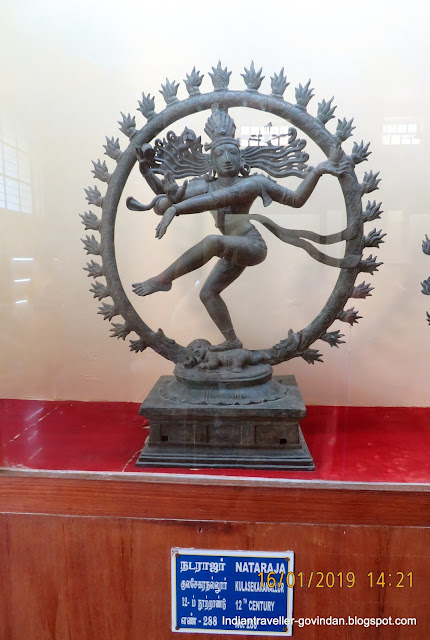Patteswaram temple is about 10 Kms from Kumbakonam.The presiding deity of the temple is Dhenupureeswarar (Shiva) and his consort Gyanambika (Parvathy).This is a fairly big temple.Though this is a Shiva temple it is more known for the Durga here. Durga is seen with eight hands each holding a conch, a chakra,a bow, an arrow, a shield and a parrot.
The legend is that the divine cow's daughter Patti worshipped Lord Shiva here and hence the name Patteswaram. There is also a well known as Koti Theertham which is supposed to be created by Lord Rama.
The Durga here is seen seated on her vahana Lion with her foot on Mahishasura. An unusual aspect
is that Durga's vehicle Lion is seen facing left instead of right. Durga in this temple is shantha swaroopi i.e. she has a peaceful appearance.
It is believed that Sri Rama did penance here after killing Vali to get over Sayagathi dosham. Sage Viswamitra became Brahma Rishi here. Ganesha is worshipped in three locations inside this temple as Anugai Pilliar, Madhuvarna Pillayar and Swarna Pillayar.
Right from the Chola period this temple is popular since it is believed that goddess Durga solves the problems of devotees and hence this temple has come to be referred as Patteswaram Durga temple.
People offer garlands made of lemon to please Durga amman.
Timings 6 am - 1 pm and 4 pm to 9 pm
UPPILIAPPAN TEMPLE
Uppiliappan temple also known as Thiruvinnagar is about 4 Kms from Kumbakonam and the temple is dedicated to Lord Vishnu. This temple is near Thirunageswaram. Lord Vishnu is worshipped as Uppiliappan and his consort Goddess Laksmi as Bhumi Devi. Here Lord Vishnu is called Uppiliappan (Uppu Illa Appan) since he does not eat salt. The temple has no salt in prasadam offered to Gods.
The temple has a five-tiered gopuram. Lord vishnu can be seen here with Bhoomi Devi on the right and Markendeya Maharishi on the left. Markendeya did a penance here to have lord Vishnu as his son in law. Lakshmi Devi in the form of an infant is found by Markendeya Rishi here.The Lord here is present in five forms viz: Ponnappan, Maniappan, Mutthappan,Vinnagarappan and Ennappan.The temple tank is called Ahorathra Pushkarani. Unlike other Theerthams, devotees can take bath during day or night.
The Lord here is known as Lord Venkatachalapathy's brother and devotees who are unable to visit
Tirupathy to fulfill their promises can do so here.
The temple construction is said to have been initiated by the Chola Kings of late 8th century with contributions from Thanjavur Nayaks.
THIRUVALANCHUZHI TEMPLE
The main deity in this temple is Sadaimudi Nathar (Shiva) and Ambal - Periyanayaki.The other deities in this temple are Swetha Vinayakar,Valanchuzhi Vinayakar, Saneeswaran, Murugan and Bhairava Moorthy.
The Lord Ganesha here is said to be Valanchuzhi Vinyakar..The white Pillayar (Lord Ganesha) is the speciality of this temple. The idol is small and is said to be made up of sea foam and hence the Vinayakar is also known as Norai Pillyar.
The story behind the temple is that the Devas started churning the ocean (Palkadal) with Mandara mountain as the churning stick and snake Vasuki as the rope. During the churning, snake Vasuki spat venom into the ocean threatening the destruction of the world. The Devas sought the help of Lord Shiva to avert the calamity and were advised by Lord Shiva to worship Lord Vinayaka. The Devas returned to Plakadal and made an idol of Lord Vinayaka from sea foam and worshipped him. They succeeded in getting 'amruth' from the palkadal. Lord Vinayaga thus made from sea foam is worshipped as Lord Swetha Vinayakar.
Swamimalai temple is near to this place. It is important to visit this temple before proceeding to Swami Malai.
Temple Timings 6 am -12 pm and 4 pm to 8 pm..
SWAMIMALAI MURURGAN TEMPLE
Swamimalai Murugan temple is located about 5 Kms from Kumbakonam.
The presiding deity is Lord Murugan who sits atop a 60 feet hillock. The temples of Lord Shiva and Goddess Parvathi are located downhill. This place is also called Tiruveragam.
As we enter, there is a temple for Lord Vinayakar (Ganesha). There are 60 steps to climb and each step is named after 60 Tamil years.
Swamimalai Murugan is also known as Swaminatha Swamy and the idol of the deity is 6 feet high. There are golden armours, a golden crown, and a diamond lance for Swaminatha Swamy. Swamymalai is the fourth of the Aarupadai Veedu or six abodes of Lord Murugan. It is said that Lord Murugan has explained the meaning of Pranava Mantra "OM" to his father Lord Shiva here.The same is seen on the gopuram depicting Murugan as Guru and Lord Shiva as his disciple.
The temple has a golden chariot made of gold, silver and metals like copper, and beautifully illuminated with electric bulbs for festivals.
The temple is an ancient one and is said to be built by Parantaka Chola -1
Timings 6 am to 12 pm and 4 pm to 10 pm












































































